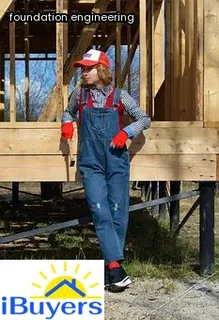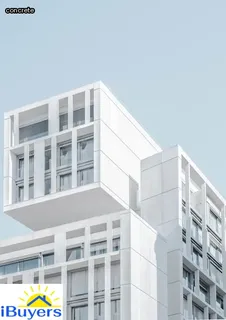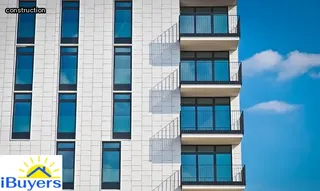When it comes to identifying foundation cracks in block foundation walls, there are a few key signs to look out for. Cracks may appear in horizontal or vertical patterns, often forming an “L” or “stair-step” shape.
They can also appear as thin lines with jagged edges, or wider gaps that show separation between blocks. Pay attention to the size and location of the crack, as well as any other visible damage such as bowing, bulging, leaning, or crumbling walls.
Foundation cracks can be caused by a variety of factors including water damage from excess moisture and poor soil conditions from inadequate drainage or compaction. It is important to diagnose the root cause of the problem before attempting repairs on the cracked wall to ensure long-term stability and strength.

Identifying a serious structural problem with a crack in a block foundation wall is no easy task, but there are certain telltale signs that can alert you to the need for professional help. A horizontal crack is often a sign of movement caused by settling or frost heave, while vertical cracks may be caused by hydrostatic pressure or overtaxed footings.
If the crack changes direction or becomes wider over time, it could indicate an issue that requires attention. If the crack is accompanied by bulging walls, sagging floors, sticking doors and windows, or other signs of foundation shifting, it is likely to be more serious than just a simple repair job.
It is important to assess any cracks in block foundations and address any underlying issues as soon as possible to prevent further damage and costly repairs.
Hairline cracks in a block foundation wall can often be easy to identify and repair, but it is important to know when they are serious enough that you should call a professional. It is normal for some hairline cracks to appear in the mortar of a block foundation due to settling and movement over time.
However, if the cracks are larger than 1/4 of an inch wide or if there are multiple fractures or vertical cracks, these may be signs of more serious structural damage and should not be ignored. You can assess whether the crack has moved, widened, or deepened by measuring it regularly with a ruler or tape measure and comparing its size over time.
If you find that any of the above has occurred, it's best to call an expert who can help you decide on the best plan for repair.

Monitoring narrow cracks in block foundation walls is an important step in identifying and repairing damage. As the temperature of the wall changes, narrow cracks can expand and cause further damage.
Homeowners should regularly check for any signs of expansion, such as wider cracks or crumbling mortar between the blocks. If a crack appears to be widening, it should be sealed immediately with mortar or a professional-grade waterproof sealant.
Regularly checking for signs of expansion in block foundation walls can help prevent costly repairs down the road.
Using concrete crack filler for wider than ⅛ inch cracks is an important step when identifying and repairing cracks in block foundation walls. The first step when using concrete crack filler to repair larger cracks is to clean the area and prepare the surface by removing any dirt, debris or loose mortar.
Once the surface is clean, you should use a brush or putty knife to evenly apply the concrete crack filler and fill in any gaps or crevices. Allow the filler to dry completely before continuing with your repairs.
After the filler has dried, you can use a trowel to smooth out any imperfections and ensure that it is firmly in place so that it will last long-term. If necessary, additional coats of concrete crack filler may be applied until all gaps are filled in and the wall looks uniform again.
With proper preparation and application, using concrete crack filler can help you successfully identify and repair larger cracks in block foundation walls.

When it comes to sealing horizontal cracks in a block foundation wall at the basement floor and wall junction, the first step is to identify the type of crack. If it is a hairline or shallow crack, often times the best course of action is to fill it with an epoxy-based product that can be found at most hardware stores.
However, if the crack is larger than ¼ inch wide then it may be necessary to use a concrete patching material instead. After identifying the type of crack, use a pressure washer to remove any dirt and debris from around the area before starting repair work.
Once cleaned, apply a caulking around the edges of the crack to create a barrier between new material and old masonry joints. Depending on which product you purchase you may need to add water or other catalyst for proper curing.
Finally, press patching material into place using your hands or a trowel and allow time for drying before continuing with any additional repairs or waterproofing treatments.
It is important to act fast when it comes to identifying and repairing cracks in block foundation walls as the longer they are left, the more likely they are to cause costly foundation leak repairs. Such repairs can be expensive and time consuming, so it is essential that homeowners are able to recognize signs of a cracked wall before any serious damage occurs.
Cracks in block foundation walls often start small but can develop into larger issues if not addressed quickly. Any crack wider than a quarter of an inch should be checked out by a professional right away.
Fortunately, there are several methods for identifying and repairing these cracks so that home foundations remain strong and stable for years to come. Homeowners should do their research or consult with an expert in order to determine which type of repair is best suited for their particular wall or situation.
Taking action quickly is the key to preventing costly foundation repair bills down the road.

If your block foundation walls have begun to bulge and large cracks have started to form, it is time to call in a professional for repair. Bulging typically indicates that the block foundation walls are being pushed outward either because of soil pressure or inadequate foundations.
Large cracks can indicate structural failure in the wall and require immediate attention. To identify the cause of the bulging and cracking, a structural engineer should be consulted in order to assess the severity of the damage and provide recommendations for repair.
Depending on the extent of damage, possible solutions may include underpinning, installation of helical piers and steel bracing, or wall anchors. Repairing block foundation walls is not something to take lightly so if you notice any signs of bulging or cracking, make sure to contact an experienced professional right away.
Identifying the type of crack in a block foundation wall can help determine the severity of the issue and if repair is necessary. There are three types of cracks that can occur: horizontal, diagonal, and vertical.
Horizontal cracks often appear due to settlement or lateral pressure from hydrostatic forces. They usually run along the mortar joints between blocks and are generally wider than the other two types.
Diagonal cracks tend to form when there is a structural problem within the wall or when soil pressure has caused movement in one direction. These may range in size from small to large depending on how badly damaged the wall is.
Vertical cracks are usually caused by shrinkage of material over time, which causes them to be narrower than horizontal cracks. It is important to inspect these cracks carefully as they may indicate larger underlying issues with your foundation walls that could cause more serious damage if not addressed promptly.
With proper identification and timely repair, block foundation walls can remain strong and stable for many years.

Cracks in block foundation walls can appear in a variety of directions and sizes, but changes in direction may be an indication of more serious structural damage. As the soil around the foundation wall moves due to changes in moisture or temperature, it can cause horizontal and vertical cracks that can worsen over time.
Uneven settling of the foundation can also lead to cracks that are wider at one end than the other. If these cracks are not addressed quickly, they could eventually become large enough to require costly repairs.
It's important to inspect your block wall for any signs of shifting or cracking, particularly if you're noticing changes in direction as this could indicate a more serious problem. Regularly checking your block wall for any signs of structural damage is essential for keeping your home safe and secure.
If you do find a crack or two, it's best to have them professionally repaired so that they don't get worse and cause further damage down the line.
It is important to take steps to help prevent future foundation problems. Regularly inspect the block foundation walls for any signs of cracking and address them quickly.
Make sure to look for cracks in the mortar joints and blocks, as well as any vertical or horizontal cracks that may have developed. Repairing the cracks early on can save a lot of money and hassle down the line.
Start by removing any loose material around the crack, then use a brush to clean out all dust and debris before patching it with cement-based masonry caulk or patching compound. If the crack is large enough, use mesh tape over it first before applying your patch.
After the patch has completely cured, paint over it with waterproof sealant or masonry sealer to further protect the wall from water damage. Taking these simple steps can ensure that your block foundation stands strong for many years ahead.

Water is the main culprit when it comes to cracking in a block foundation wall. As water accumulates and becomes pressurized, the pressure can cause cracks to form in the blocks of the foundation.
These cracks often start small, but if left untreated, they can become larger and more severe. Identifying and repairing these cracks is essential for preserving your home's structural integrity.
One way to identify a crack is by looking for signs of water intrusion on interior walls such as damp spots or staining. If you discover a crack in your block foundation wall, there are several solutions that can help repair and prevent further damage.
Sealing with an elastomeric sealant may be effective for minor cracks, while installing carbon fiber reinforcement may help prevent further cracking or movement in a severely damaged area. Finally, proper drainage around the perimeter of your home can help reduce water pressure and minimize the chances of future cracking.
Repairing block foundation walls with cracked walls is a complex process that involves identifying the type of damage, assessing the severity of the cracks, and then selecting the appropriate repair method. It is vital to inspect the area around the crack in order to determine if there are any other structural issues that could be causing or contributing to it.
If there are other issues, these must be addressed before attempting a repair. The most common repairs for cracked block foundation walls involve applying an epoxy-based paste to fill in any gaps and then reinforcing this with mesh or steel bars.
For more serious cracks, it may be necessary to install a new concrete footing and use a hydraulic cement grout to seal up existing cracks. Regardless of what type of repair is needed, it is important that all work is done according to building codes and standards in order to ensure safety and effectiveness.

Identifying and repairing cracks in block foundation walls can be a daunting task, but it doesn't have to be. With the right tools and knowledge, you can easily tackle this project step-by-step.
Start by locating any visible cracks in the block foundation walls, which can range from hairline to large fissures. If you notice any water seepage or discoloration around the crack, use a sealant to fill in the crevice before proceeding.
Once the sealant is dry, use a hammer and chisel to chisel out any loose material around the crack until you reach solid concrete. Then clean out the area with a wire brush or vacuum to ensure it’s free of debris before applying mortar mix along the edges of the crack.
Use a trowel to smooth out the mortar for an even finish and let it dry completely before continuing on with your repair project. Finally, apply waterproofing paint overtop of all repaired areas and let dry for 24 hours before inspecting your work for any additional repairs that need to be made.
With this simple step-by-step guide, identifying and repairing cracks in block foundation walls won't seem like such an intimidating task after all!.
Unseen water damage to foundations can be caused by a variety of sources, including cracks in the block foundation walls. In order to identify and repair these cracks, it is important to understand what causes them in the first place, as this will dictate how best to go about repairing them.
Foundation wall cracks often result from changes in soil moisture levels or pressure on the wall due to nearby trees and shrubs. Poor draining around the outside of the foundation can also cause water damage as it pools against the wall and seeps into small cracks, weakening it over time.
Cracks from settling are also common; as soils settle and sink beneath a house's foundation walls, they can create more stress on the walls and cause cracking. Lastly, freezing temperatures can cause expansion that can lead to cracking in block foundations.
It is important for homeowners to identify these various sources of unseen water damage so that they can properly address any existing issues with their foundation and prevent further damage from occurring.

Poor drainage around the home's perimeter can lead to a number of issues, including cracks in block foundation walls. Spotting signs of poor drainage is not always easy, but there are certain telltale indicators that homeowners should recognize and address as soon as possible.
When inspecting the outside of your home, look for pooling water near the foundation or soggy soil in the area. Take note if you see any vegetation growing close to the foundation wall; this could indicate that groundwater is settling against it and eroding away at its surface.
Additionally, inspect gutters and downspouts regularly to make sure they're properly draining away from the house. If you notice any standing water after a rainstorm, this is an indication that water isn't flowing away from your home correctly and should be addressed immediately.
Examining the soil type and compaction around a home's foundation is an important step in identifying and repairing cracks in block foundation walls. The type of soil surrounding the foundation can affect its stability and how prone it is to cracking.
Compaction is also essential, as too much or too little can cause shifting and instability. To ensure that the soil type and compaction levels are acceptable for your home’s foundation, it should be inspected by a professional contractor.
Gutter systems and downspouts should also be checked to make sure they are functioning properly. Poorly-functioning gutters can disrupt drainage, leading to erosion underneath the home’s foundation, which can cause cracking.
Additionally, exterior grading needs to be examined to make sure there is sufficient slope away from the home. This will help reduce water buildup near the foundation walls that could lead to seepage and cracking over time.
Step cracks in foundation walls can be a serious issue that should not be ignored. If left untreated, these cracks can cause significant structural damage to the building and lead to costly repairs.
Step cracks occur when one side of the foundation wall shifts in relation to the other side, creating an offset step or crack between them. These step cracks are usually caused by settlement issues due to soil movement or improper construction techniques.
Structural engineers and contractors should be consulted to identify and assess the seriousness of any step cracks found in a foundation wall. Repairing step cracks may involve underpinning, piers, or helical anchors depending on the situation.
It is important that any repairs are done properly and monitored afterward for signs of continued shifting or cracking. Ignoring step cracks in a block foundation wall could lead to much more serious problems down the line and should not be taken lightly.

Stair step cracks in block foundation walls can be fixed, although the repair process depends on the severity of the damage. In order to identify and repair stair step cracks, a thorough inspection should be done by a qualified professional to properly assess the extent of the damage.
The evaluation will include an examination of the wall’s drainage system, soil type and any signs of settling or shifting. Minor stair step cracks can usually be repaired with epoxy injection or masonry sealant, while more severe damage may require additional reinforcing or even a full-wall replacement.
It is important to note that repairs made without first evaluating the underlying cause of the crack may not stand up over time.
Are cracks in a block foundation normal? When it comes to your home's foundation, the answer is both yes and no. It is important to understand what constitutes a normal crack versus an abnormal one.
Normal cracking in a block foundation is typically caused by shrinkage as the concrete cures, thermal expansion and contraction from temperature changes, or minor settling of the soil beneath it. These types of cracks are generally small and are not cause for concern.
However, if you see cracks that are large, increase in size over time, or have other signs of structural damage then it is likely that you need to call a professional to repair them. Identifying and repairing cracks in block foundations can be done through simple steps such as inspecting for signs of damage and moisture seepage, checking for vertical displacement, filling any existing cracks with mortar mix or epoxy injection, and sealing the affected area with waterproofing sealant.
Taking these steps will help ensure that your home's foundation remains strong and stable for years to come.
Are cracks in cinder block foundation walls bad? The answer is yes, they can be. Cracks in your cinder block foundation walls can cause structural damage, water leakage, and other problems that could be expensive to repair. Identifying and repairing cracks in cinder block foundations early is important to preventing further damage.
Knowing how to identify and repair cracks in cinder block foundation walls will help you maintain the integrity of your home's structure and keep repair costs down. Cracks in a cinder block foundation wall are typically caused by settlement or poor construction of the foundation; however, natural disasters like earthquakes or floods can also cause them. If left unrepaired, these cracks can worsen over time, leading to costly repairs or even replacement of the entire wall.
To identify a crack in a cinder block foundation wall, look for small gaps between blocks or mortar joints that have grown wider over time; if these gaps are larger than 1/4 inch across, then it's likely that you have a crack. Once identified, there are several ways to repair the crack depending on its severity. For minor cracks, homeowner’s may opt for an epoxy injection which involves injecting an epoxy into the crack from both sides of the wall until it is full and securely sealed; this method works best when done professionally but can also be done by homeowners with experience and access to the right tools.
Other methods such as mud jacking or carbon fiber reinforcing may also be necessary depending on the size and location of the crack(s). Ultimately, whether you choose to repair cracks yourself or hire a professional contractor, it’s important to make sure repairs are done correctly so that your home’s structure remains sound for years to come.
A: Step cracks in concrete block foundations can often be repaired using an epoxy injection system. Poured concrete and CMU (Concrete Masonry Unit) foundations may require other types of repairs, such as mudjacking or the installation of helical piers.
A: One way to repair step cracks in a brick masonry wall without creating a drainage channel is to inject epoxy or polyurethane foam into the crack. This will fill and seal the crack, and prevent water from entering the crawl space.

A: Step cracks in a block foundation should be filled with a concrete patching compound. The compound should be mixed with water, then troweled into the crack until it is level with the foundation surface. Allow the patch to dry fully before painting or sealing the area.
A: To repair step cracks in a block foundation caused by tree roots and excessive rainfall, you should first remove any broken fragments of block from the crack. Then, fill the crack with a concrete patching compound. Finally, reinforce the crack with a steel plate to ensure lasting stability.
A: Clay can be used as a mortar to fill the step cracks and re-secure the block foundation.

A: Step cracks in a block foundation can be repaired by cleaning the surface of the crack with an angle grinder, filling the crack with an appropriate masonry sealant or epoxy, and smoothing the sealant level with a putty knife.
A: Step cracks in block foundation walls are typically caused by settling or soil movement. To identify them, look for horizontal lines that form a “step-like” pattern and appear at regular intervals. To repair them, use a concrete caulk or patching compound to fill and seal the cracks.